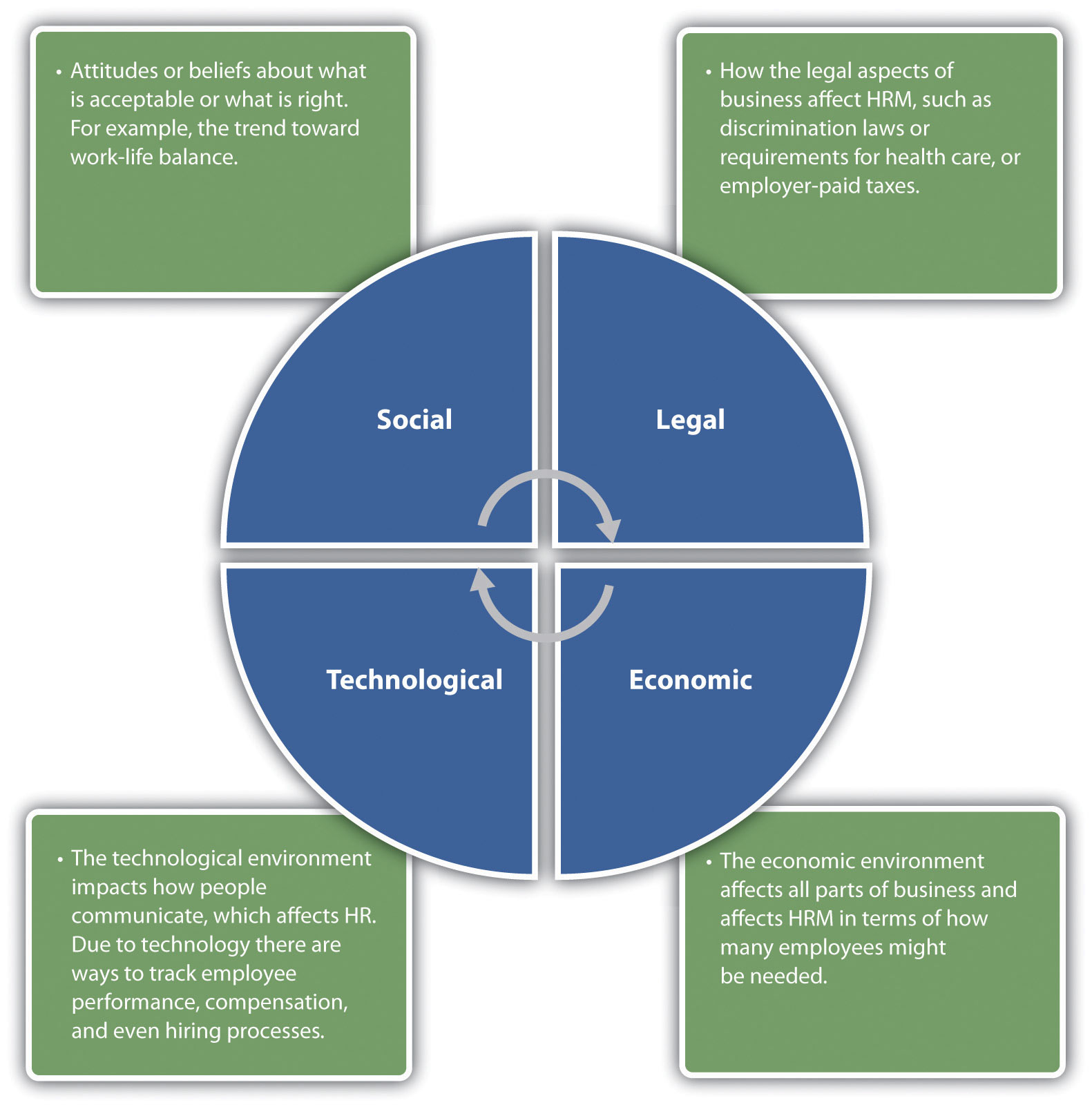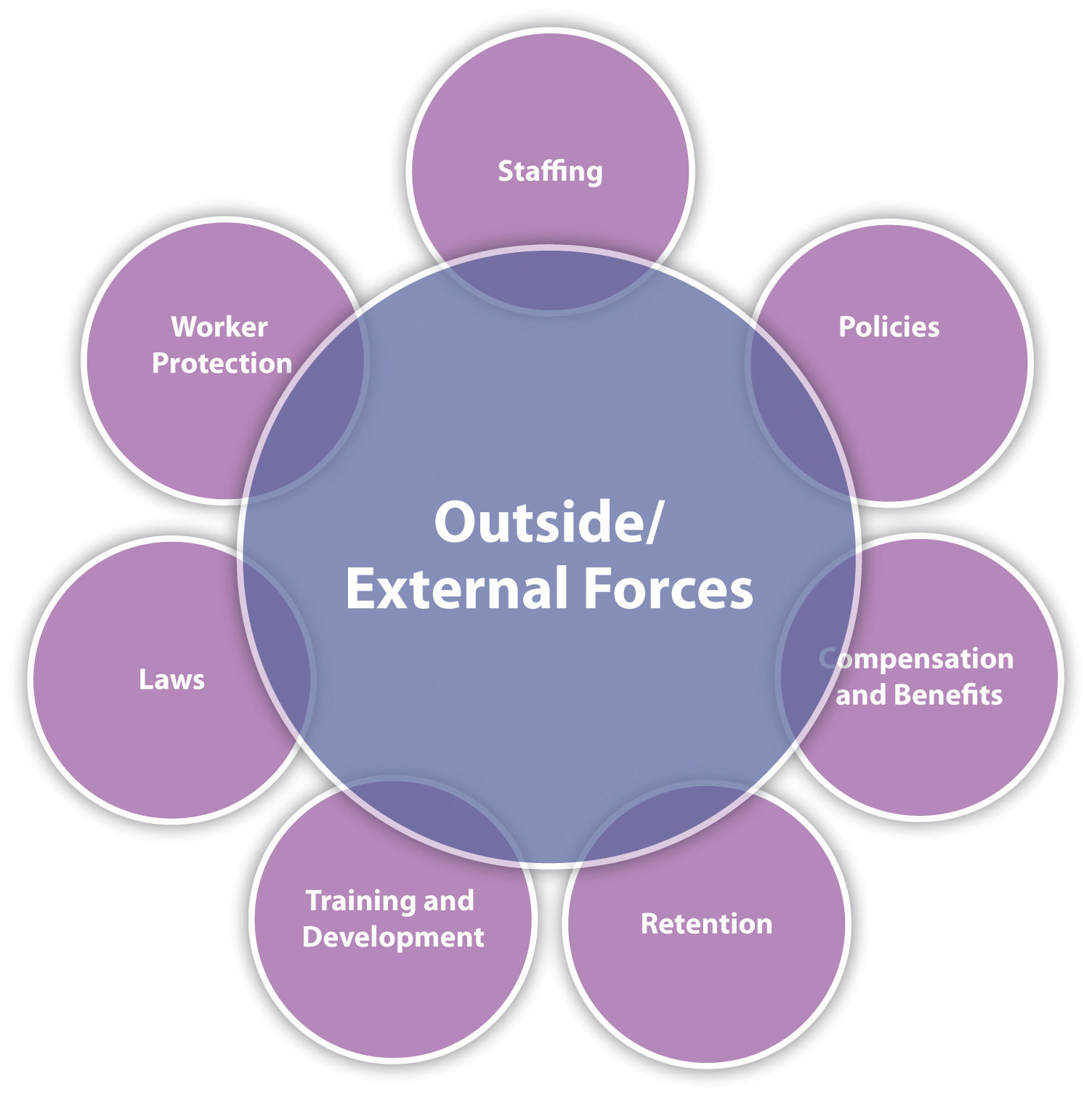6 What Is Human Resources?
Competencies
- Explain the role of Human Resources Management (HRM) in organizations.
- Define and discuss some of the major HRM activities.
Every organization, large or small, uses a variety of capital to make the business work. Capital includes cash, valuables, or goods used to generate income for a business. For example, a retail store uses registers and inventory, while a consulting firm may have proprietary software or buildings. No matter the industry, all companies have one thing in common: they must have people to make their capital work for them. This will be our focus throughout the text: generation of revenue through the use of people’s skills and abilities.
What Is Human Resource Management (HRM)?
Human resource management (HRM) is the process of employing people, training them, compensating them, developing policies relating to them, and developing strategies to retain them. As a field, HRM has undergone many changes over the last twenty years, giving it an even more important role in today’s organizations. In the past, HRM meant processing payroll, sending birthday gifts to employees, arranging company outings, and making sure forms were filled out correctly—in other words, more of an administrative role rather than a strategic role crucial to the success of the organization. Jack Welch, former CEO of General Electric and management guru, sums up the new role of HRM: “Get out of the parties and birthdays and enrollment forms.… Remember, HR is important in good times, HR is defined in hard times” (Frasch, et. al., 2010).
It’s necessary to point out here, at the very beginning of this text, that every manager has some role relating to human resource management. Just because we do not have the title of HR manager doesn’t mean we won’t perform all or at least some of the HRM tasks. For example, most managers deal with compensation, motivation, and retention of employees—making these aspects not only part of HRM but also part of management. As a result, this book is equally important to someone who wants to be an HR manager and to someone who will manage a business.
Human Resource Recall
Have you ever had to work with a human resource department at your job? What was the interaction like? What was the department’s role in that specific organization?
The Role of HRM
Keep in mind that many functions of HRM are also tasks other department managers perform, which is what makes this information important, despite the career path taken. Most experts agree on seven main roles that HRM plays in organizations.
Even if you are the owner of a business, you wear many hats and one of those hats is that of Human Resource manager.
Here are the roles HRM plays in organizations:
Staffing
You need people to perform tasks and get work done in the organization. Even with the most sophisticated machines, humans are still needed. Because of this, one of the major tasks in HRM is staffing. Staffing involves the entire hiring process from posting a job to negotiating a salary package. Within the staffing function, there are four main steps:
- Development of a staffing plan. This plan allows HRM to see how many people they should hire based on revenue expectations.
- Development of policies to encourage multiculturalism at work. Multiculturalism in the workplace is becoming more and more important, as we have many more people from a variety of backgrounds in the workforce.
- Recruitment. This involves finding people to fill the open positions.
- Selection. In this stage, people will be interviewed and selected, and a proper compensation package will be negotiated. This step is followed by training, retention, and motivation.
Development of Workplace Policies
Every organization has policies to ensure fairness and continuity within the organization. One of the jobs of HRM is to develop the verbiage surrounding these policies. In the development of policies, HRM, management, and executives are involved in the process. For example, the HRM professional will likely recognize the need for a policy or a change of policy, seek opinions on the policy, write the policy, and then communicate that policy to employees. It is key to note here that HR departments do not and cannot work alone. Everything they do needs to involve all other departments in the organization. Some examples of workplace policies might be the following:
- Discipline process policy
- Vacation time policy
- Dress code
- Ethics policy
- Internet usage policy
These topics are addressed further in upcoming chapters.
Compensation and Benefits Administration
HRM professionals need to determine that compensation is fair, meets industry standards, and is robust enough to entice people to work for the organization. Compensation includes anything the employee receives for his or her work. In addition, HRM professionals need to make sure the pay is comparable to what other people performing similar jobs are being paid. This involves setting up pay systems that take into consideration the number of years with the organization, years of experience, education, and similar aspects. Examples of employee compensation include the following:
- Pay
- Health benefits
- 401(k) (retirement plans)
- Stock purchase plans
- Vacation time
- Sick leave
- Bonuses
- Tuition reimbursement
Since this is not an exhaustive list, compensation is discussed further later in the book.
Retention
Retention involves keeping and motivating employees to stay with the organization. Compensation is a major factor in employee retention, but there are other factors as well. Ninety percent of employees leave a company for the following reasons:
- Issues around the job they are performing
- Challenges with their manager
- Poor fit with organizational culture
- Poor workplace environment
Despite this, 90 percent of managers think employees leave as a result of pay (Rivenbark, 2010). As a result, managers often try to change their compensation packages to keep people from leaving, when compensation isn’t the reason they are leaving at all.
Training and Development
Once we have spent the time to hire new employees, we want to make sure they not only are trained to do the job but also continue to grow and develop new skills in their job. This results in higher productivity for the organization. Training is also a key component in employee motivation. Employees who feel they are developing their skills tend to be happier in their jobs, which results in increased employee retention. Examples of training programs might include the following:
- Job skills training, such as how to run a particular computer program
- Training on communication
- Team-building activities
- Policy and legal training, such as sexual harassment training and ethics training
We address each of these types of training and more in detail later.
Dealing with Laws Affecting Employment
Human resource people must be aware of all the laws that affect the workplace. An HRM professional might work with some of these laws:
- Discrimination laws
- Health-care requirements
- Compensation requirements such as the minimum wage
- Worker safety laws
- Labor laws
The legal environment of HRM is always changing, so HRM must always be aware of changes taking place and then communicate those changes to the entire management organization. Rather than presenting a chapter focused on HRM laws, we will address these laws in each relevant chapter.
Worker Protection
Safety is a major consideration in all organizations. Oftentimes new laws are created with the goal of setting federal or state standards to ensure worker safety. Unions and union contracts can also impact the requirements for worker safety in a workplace. It is up to the human resource manager to be aware of worker protection requirements and ensure the workplace is meeting both federal and union standards. Worker protection issues might include the following:
- Chemical hazards
- Heating and ventilation requirements
- Use of “no fragrance” zones
- Protection of private employee information

Caption: Knowing the law regarding worker protection is generally the job of human resources. In some industries it is extremely important; in fact, it can mean life or death.
ReSurge International – Tom Davenport Operating On A Patient – CC BY-NC-ND 2.0.
Communication
Besides these major roles, good communication skills and excellent management skills are key to successful human resource management as well as general management.
Awareness of External Factors
In addition to managing internal factors, the HR manager needs to consider the outside forces at play that may affect the organization. Outside forces, or external factors, are those things the company has no direct control over; however, they may be things that could positively or negatively impact human resources. External factors might include the following:
- Globalization
- Worldwide crises like COVID
- Changes to employment law
- Health-care costs
- Employee expectations
- Diversity of the workforce
- Changing demographics of the workforce
- A more highly educated workforce
- Layoffs and downsizing
- Technology used, such as HR databases
- Increased use of social networking to distribute information to employees
For example, the recent trend in flexible work schedules (allowing employees to set their own schedules) and telecommuting (allowing employees to work from home or a remote location for a specified period of time, such as one day per week) are external factors that have affected HR. COVID has really fast tracked flexibility in the workplace and it is here to stay.
HRM has to be aware of outside issues, so they can develop policies that meet not only the needs of the company but also the needs of the individuals.
Another example is law. On September 11, 2020, the U.S. Department of Labor’s Wage and Hour Division (WHD) announced revisions to regulations that implement the paid sick leave and expanded family and medical leave provisions of the Families First Coronavirus Response Act (FFCRA). The revised rule clarifies workers’ rights and employers’ responsibilities regarding FFCRA paid leave. The rule was issued in light of the U.S. District Court for the Southern District of New York’s August 3, 2020, decision invalidating portions of the relevant regulations.
The revisions allow WHD to enforce critical legal protections for millions of workers fully and fairly. Compliance with this bill has huge implications for HR.
Any manager operating without considering outside forces will likely alienate employees, resulting in unmotivated, unhappy workers. Not understanding the external factors can also mean breaking the law, which has a concerning set of implications as well.
The analysis of external factors is an ongoing process for HRM and other leadership within companies.
One way managers can be aware of the outside forces is to attend conferences and read various articles on the web. For example, the website of the Society for Human Resource Management, SHRM Online1, not only has job postings in the field but discusses many contemporary human resource issues that may help the manager make better decisions when it comes to people management.
Key Takeaways
- Capital includes all resources a company uses to generate revenue. Human resources or the people working in the organization are the most important resource.
- Human resource management is the process of employing people, training them, compensating them, developing policies relating to the workplace, and developing strategies to retain employees.
- There are seven main responsibilities of HRM managers: staffing, setting policies, compensation and benefits, retention, training, employment laws, and worker protection. In this book, each of these major areas will be included in a chapter or two.
- In addition to being concerned with the seven internal aspects, HRM managers must keep up to date with changes in the external environment that may impact their employees. The trends toward flexible schedules and telecommuting are examples of external aspects.
- To effectively understand how the external forces might affect human resources, it is important for the HR manager to read the HR literature, attend conferences, and utilize other ways to stay up to date with new laws, trends, and policies.
Exercises
- State arguments for and against the following statement: there are other things more valuable in an organization besides the people who work there.
- Of the seven tasks an HR manager does, which do you think is the most challenging? Why?
1Society for Human Resource Management, accessed August 18, 2011, http://www.shrm.org/Pages/default.aspx.
References
Cappelli, P., “HR Implications of Healthcare Reform,” Human Resource Executive Online, March 29, 2010, accessed August 18, 2011, http://www.hreonline.com/HRE/story.jsp?storyId=379096509.
Frasch, K. B., David Shadovitz, and Jared Shelly, “There’s No Whining in HR,” Human Resource Executive Online, June 30, 2009, accessed September 24, 2010, http://www.hreonline.com/HRE/story.jsp?storyId=227738167.
Rivenbark, L., “The 7 Hidden Reasons Why Employees Leave,” HR Magazine, May 2005, accessed October 10, 2010, http://findarticles.com/p/articles/mi_m3495/is_5_50/ai_n13721406.



